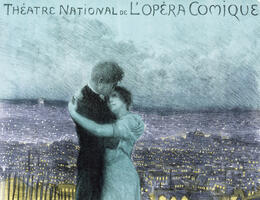Louise

Charpentier first sketched Louise in the late 1880s, in Rome, but he did most of the work on his “musical novel in four acts and five scenes” between 1893 and 1896. At a time when librettos were always written in verse, Charpentier chose to write his in prose (probably with the collaboration of Saint-Pol Roux). The première, on 2 February 1900 at the Opéra-Comique, with Messager conducting, was a triumphant success. In this naturalist opera, the composer shows his affinity for socialist ideas, no doubt stemming from his modest family background (he was the son of a baker). He also addresses the theme of free love, since the heroine, who comes from a working-class background, leaves her family and her job as a milliner to live with the poet Julien. The work opposes classes and generations, but it is not just a realistic slice of life (“La soupe est prête?” asks the father on his return home from work): the love story between Louise and Julien exploits the sentimental fibre in a Paris that becomes a real character (Montmartre with its festivities, in Act III, symbolises freedom and passion). Musically, Charpentier takes his cue from Massenet and Wagner, composing the choruses and orchestral interludes with care, unifying the score by means of leitmotifs (the main one, based on an arpeggio, is heard in the very first bars). The characters sing mostly in arioso style, with occasionally a display of intense effusion (Louise’s “Depuis le jour où je me suis donnée”, Act III). Charpentier did not repeat this feat of brilliance. In 1913, Julien, the sequel to Louise, won critical respect but was not a popular success.
Documents and archives

Press illustration, Picture of a scene, Photograph
Scène de Louise de Charpentier : acte II, 1er tableau
Scientific publications
Publication
Gustave Charpentier et son temps
Publication



